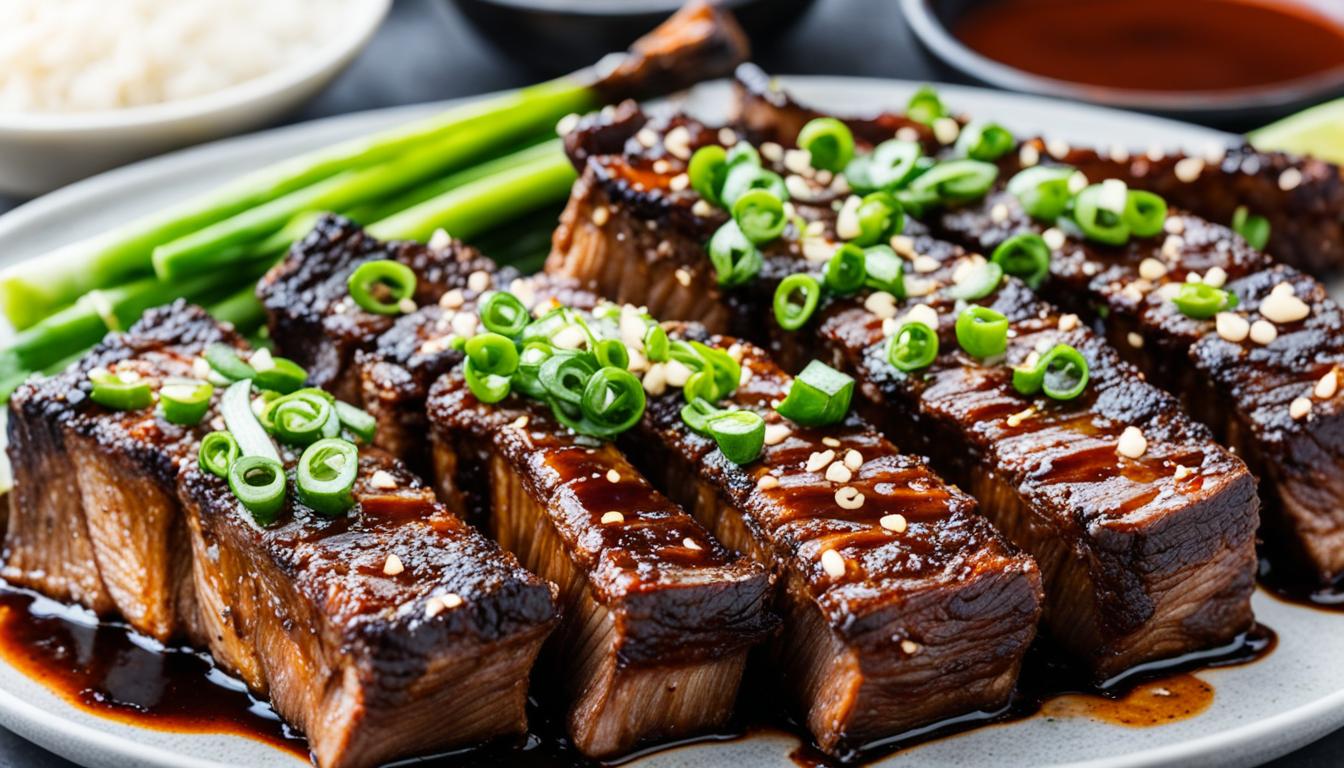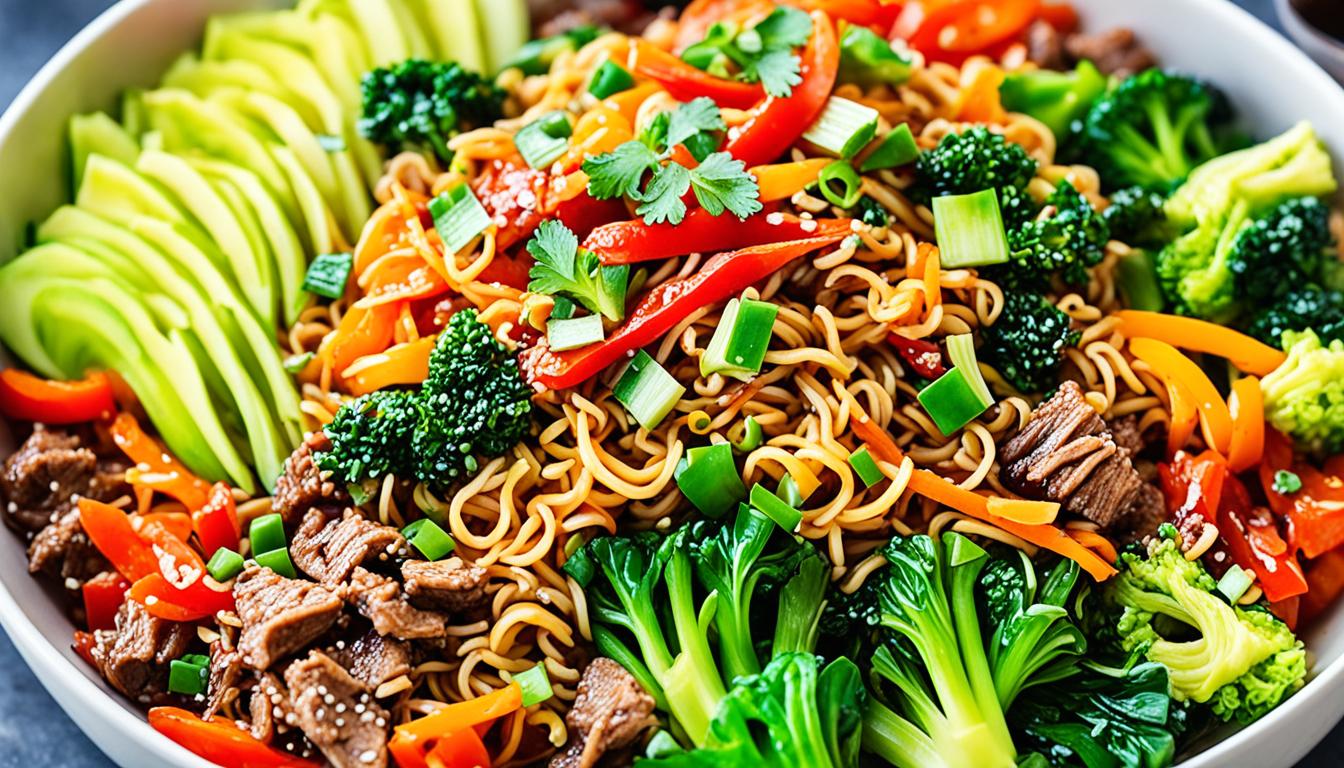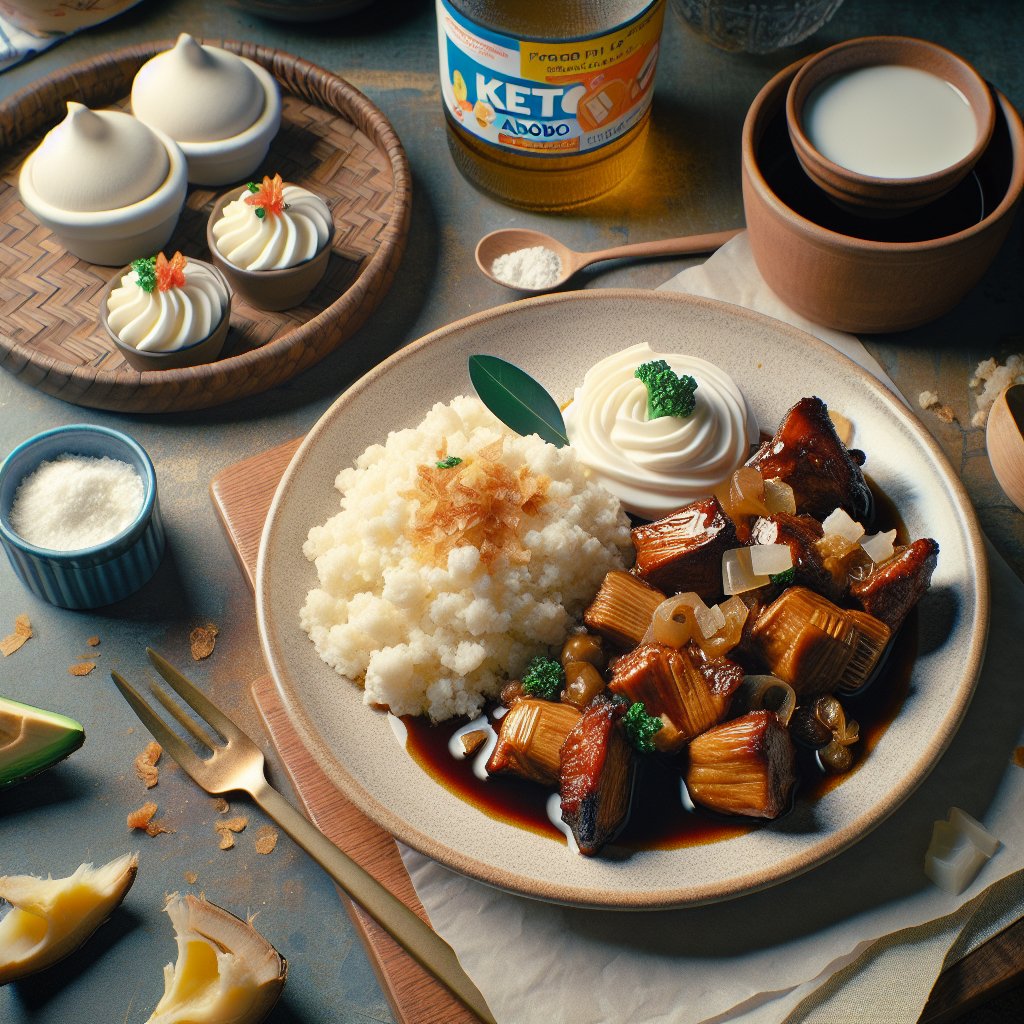Are you following a ketogenic diet but still crave the bold and vibrant flavors of Korean cuisine? I’ve been there. As a lover of all things Korean food, I was hesitant to give up my favorite dishes when I started my keto journey. But guess what? You don’t have to! With a few simple swaps and substitutions, you can create mouthwatering Korean keto recipes that are low in carbs but still bursting with authentic flavors.
Whether you’re a fan of spicy seafood ramen, succulent beef bulgogi, or classic bibimbap, there’s a keto-friendly version waiting for you to try. In this article, I’ll share some tips for making Korean dishes keto-friendly and guide you through some easy and healthy Korean keto recipes that will satisfy your cravings without derailing your low-carb lifestyle.
Key Takeaways:
- By swapping out high-carb ingredients and using keto-friendly alternatives, you can enjoy the flavors of Korean cuisine without compromising your low-carb lifestyle.
- Choose cauliflower rice or low-carb noodles as a replacement for traditional rice to reduce the carb content of your dishes.
- Modify sauces and marinades by using sugar substitutes like monk fruit or coconut aminos to keep the sugar content low.
- Incorporate low-carb vegetables like zucchini, cabbage, and spinach into your Korean keto recipes for added nutrition and flavor.
- Explore a variety of keto-friendly options such as galbi, spicy seafood ramen, bibimbap, beef bulgogi, and ramen stir fry to enjoy the vibrant and satisfying flavors of Korean cuisine.
Tips for Making Korean Dishes Keto-Friendly
When it comes to enjoying keto-friendly Korean food, there are some essential tips you should know. By making a few simple adjustments, you can transform traditional Korean dishes into healthy low-carb options without sacrificing flavor. Here are some strategies to keep in mind:
1. Substitute Carbs
To reduce the carb content of Korean dishes, replace traditional rice with cauliflower rice. This keto-friendly alternative provides a similar texture and pairs well with Korean flavors. You can also try low-carb noodles like immi ramen or zucchini noodles as a replacement.
2. Mindful of Sauces and Marinades
Many traditional Korean sauces and marinades contain added sugars, which can significantly impact the carb count of a dish. To maintain a keto-friendly profile, check labels for hidden sugars and seek out alternative ingredients. Coconut aminos and monk fruit sweetener are excellent replacements for sugar-laden sauces.
3. Embrace Low-Carb Vegetables
Incorporate low-carb vegetables, such as zucchini, cabbage, and spinach, into your keto-friendly Korean recipes. These nutrient-dense options add volume, texture, and flavor without the high carb content of starchy vegetables like potatoes or corn.
| Tips for Making Korean Dishes Keto-Friendly | Description |
|---|---|
| Substitute Carbs | Replace traditional rice with cauliflower rice or opt for low-carb noodles like immi ramen or zucchini noodles. |
| Mindful of Sauces and Marinades | Check labels for hidden sugars and consider using alternative ingredients like coconut aminos or monk fruit sweetener. |
| Embrace Low-Carb Vegetables | Incorporate low-carb vegetables such as zucchini, cabbage, and spinach into your dishes. |
By following these tips, you can enjoy delicious and healthy keto-friendly Korean dishes right in your own home.
Korean Keto Recipe: Galbi (Korean Beef Short Ribs)
Galbi, also known as Korean beef short ribs, is a perfect keto-friendly option for meat lovers. The marinade for galbi typically includes ingredients like jalapenos, sesame oil, garlic, and soy sauce. To make it keto-friendly, you can replace the sugar with a sugar substitute like monk fruit. After marinating the beef short ribs, they can be grilled or seared to perfection. Serve with toasted sesame seeds and green onions for added flavor and visual appeal.

Short ribs are a popular cut of beef known for their meaty flavor and tenderness. Galbi is a traditional Korean dish that showcases the rich flavors of beef short ribs. The marinade adds depth and complexity to the meat, creating a delicious and satisfying meal.
The combination of jalapenos, sesame oil, garlic, and soy sauce in the marinade enhances the natural flavors of the beef, while the addition of monk fruit as a sugar substitute keeps the dish low in carbs. Grilling or searing the marinated beef short ribs provides a smoky and caramelized crust, further enhancing the taste.
To serve, sprinkle toasted sesame seeds on top of the galbi for an extra crunchy texture. The green onions add freshness and a pop of color to the dish, enhancing its visual appeal.
“Galbi is a classic Korean dish that is loved for its rich flavors. By adapting it to a keto-friendly version, you can enjoy the authentic taste of Korean cuisine while sticking to your low-carb lifestyle.”
| Ingredients | Instructions |
|---|---|
|
|
Korean Keto Recipe: Spicy Seafood Ramen (Jjamppong)
If you’re craving a comforting bowl of ramen while on a keto diet, try making a spicy seafood ramen, or jjamppong. This Korean-Chinese noodle soup is packed with flavors and can easily be made low-carb.
Here’s a breakdown of the key components:
Veggie Base
- Zucchini
- Cabbage
- Mushrooms
These vegetables provide a delicious and nutritious foundation for your spicy seafood ramen, while keeping the carb content low. Be sure to slice the zucchini and cabbage into thin strips for a noodle-like texture.
Protein Options
- Pork belly
- Octopus or squid
- Clams
- Mussels
- Shrimp
Choose your favorite combination of seafood and add it to the soup for a protein-packed meal. These options are not only flavorful but also compatible with a low-carb diet.
Flavor Enhancers
- Gochujang
- Garlic
- Ginger
- Gochugaru (Korean chili flakes)
These traditional Korean ingredients provide the signature heat and flavor to your spicy seafood ramen. Adjust the quantities based on your preferred level of spiciness.
For the finishing touch, add low-carb ramen noodles that are available in many stores or online. These noodles are made from alternative ingredients such as konjac flour and are a great substitute for traditional high-carb ramen noodles.
With just a few adjustments, you can enjoy a comforting and satisfying bowl of spicy seafood ramen that fits perfectly into your keto diet. Give this recipe a try and savor the bold flavors of Korean cuisine while staying on track with your low-carb goals.
Korean Keto Recipe: Bibimbap
Bibimbap is a classic Korean dish that can be easily adapted to a keto diet. Traditionally, bibimbap consists of steamed white rice, various vegetables, and a choice of meat, usually topped with a fried egg and served with a spicy sauce. For a keto-friendly version, substitute the rice with cauliflower rice or another low-carb alternative. Load up on non-starchy vegetables like spinach, mushrooms, and bean sprouts. For the protein, you can use options like ground beef, chicken, or tofu. Top with a crispy fried egg and drizzle with sesame oil or serve with a side of kimchi for added flavor.
| Ingredients: | Instructions: |
|---|---|
|
|
Korean Keto Recipe: Beef Bulgogi
Beef bulgogi is a delicious and popular Korean dish that can easily be adapted to fit a keto diet. Made with thin slices of marinated beef, this dish is packed with flavor and can be enjoyed guilt-free. By making a few simple adjustments, you can create a keto-friendly version of beef bulgogi that is both satisfying and low in carbs.
To make your beef bulgogi keto-friendly, start by substituting the sugar in the marinade with a sugar substitute like erythritol or use a low-carb sweetener like stevia. This will help reduce the carb content without sacrificing the taste.
For the marinade, combine soy sauce, sesame oil, garlic, and ginger in a bowl. These ingredients add depth and richness to the flavor of the beef.
Choose thinly sliced ribeye or sirloin steak for your beef bulgogi. These cuts of meat are tender and cook quickly, making them perfect for this dish.
Once the beef is marinated, you can quickly cook it on the stovetop or grill it for added smokiness. The key is to cook the beef until it’s tender and flavorful.
Serve your beef bulgogi with a side of cauliflower rice or low-carb noodles for a complete and satisfying meal. The cauliflower rice provides a great low-carb alternative to traditional rice, while the noodles add a bit of texture to the dish.
Ingredients:
- Thinly sliced ribeye or sirloin steak
- 3 tablespoons soy sauce
- 1 tablespoon sesame oil
- 2 cloves garlic, minced
- 1 teaspoon grated ginger
- 1 tablespoon erythritol (or other sugar substitute)
Instructions:
- In a bowl, mix together the soy sauce, sesame oil, minced garlic, grated ginger, and erythritol.
- Add the thinly sliced beef to the marinade and mix well. Let it marinate for at least 30 minutes, or overnight for a more intense flavor.
- Cook the marinated beef on the stovetop or grill until cooked through and tender.
- Serve with cauliflower rice or low-carb noodles.
Enjoy this keto-friendly version of beef bulgogi and savor the authentic flavors of Korean cuisine without compromising your diet goals.
Korean Keto Recipe: Ramen Stir Fry
A ramen stir fry is an excellent keto-friendly option for those craving the flavors of Korean cuisine. Upgrade your regular packaged ramen noodles to a low-carb, high-protein option. Replace high-carb vegetables like carrots with keto-friendly options such as broccoli or swiss chard. Don’t forget to add protein, like shrimp or beef brisket, and incorporate plenty of low-carb vegetables like cabbage and kale. This dish is a great way to clean out your fridge and enjoy a delicious, low-carb meal.
For a satisfying and flavorful ramen stir fry, follow the recipe below:
- Start by gathering the following ingredients:
| Ingredients: | Quantity: |
|---|---|
| Low-carb ramen noodles | 1 package |
| Protein (shrimp or beef brisket) | 8-10 ounces |
| Low-carb vegetables (broccoli, swiss chard, cabbage, kale) | 2 cups |
| Garlic, minced | 2 cloves |
| Soy sauce | 2 tablespoons |
| Sesame oil | 1 tablespoon |
| Red pepper flakes (optional) | To taste |
| Salt and pepper | To taste |
- Prepare the low-carb ramen noodles according to the package instructions. Drain and set aside.
- In a large skillet or wok, heat the sesame oil over medium heat. Add the minced garlic and sauté until fragrant.
- Add the protein of your choice to the skillet and cook until browned and cooked through.
- Add the low-carb vegetables to the skillet and stir fry until they are crisp-tender.
- Add the cooked ramen noodles to the skillet and toss to combine with the vegetables and protein.
- Drizzle the soy sauce over the stir fry and season with salt, pepper, and red pepper flakes, if desired.
- Cook for an additional 2-3 minutes, stirring occasionally, until everything is well coated and heated through.
- Remove from heat and serve the ramen stir fry hot.
Enjoy this delicious and satisfying ramen stir fry as a keto-friendly alternative to traditional Korean ramen dishes. The combination of low-carb noodles, protein, and vegetables makes it a perfect choice for those following a keto diet.

Conclusion
Discovering the world of Keto Korean recipes opens up a whole new realm of culinary possibilities. By making simple adjustments and substitutions, you can indulge in the vibrant flavors of traditional Korean cuisine while staying true to your low-carb lifestyle. Whether you’re craving succulent beef short ribs, fiery spicy seafood ramen, a nourishing bowl of bibimbap, or a sizzling plate of beef bulgogi, there’s a wealth of healthy options to explore.
Creating delicious and satisfying meals doesn’t have to mean compromising your health goals. By choosing low-carb ingredients and being mindful of hidden sugars in sauces and marinades, you can enjoy the authentic taste of Korean dishes without guilt. Embrace the versatility of cauliflower rice, veggie-based noodles, and an abundance of low-carb vegetables like zucchini and cabbage to elevate your Korean keto creations.
Don’t be afraid to get creative in the kitchen. Experiment with different recipes and make them your own. Let the bold and aromatic flavors of Korean cuisine ignite your taste buds while keeping you on track with your keto journey. With healthy Korean recipes at your fingertips, the fusion of ketogenics and Korean cuisine has never been more exciting. So why settle for anything less when you can savor the best of both worlds?
FAQ
How can I make Korean dishes keto-friendly?
There are several ways to make Korean dishes keto-friendly. You can substitute cauliflower rice for traditional rice, choose low-carb noodles like immi ramen or zucchini noodles, and be mindful of sauces and marinades that may contain hidden sugars. Focus on incorporating low-carb vegetables into your dishes.
What are some keto-friendly Korean recipes I can try at home?
Some keto-friendly Korean recipes you can try at home include Galbi (Korean Beef Short Ribs), Spicy Seafood Ramen (Jjamppong), Bibimbap, Beef Bulgogi, and Ramen Stir Fry. These recipes have been adapted to be low in carbs but still packed with authentic flavors.
How can I make Galbi (Korean Beef Short Ribs) keto-friendly?
To make Galbi keto-friendly, you can replace the sugar in the marinade with a sugar substitute like monk fruit. After marinating the beef short ribs, they can be grilled or seared to perfection and served with toasted sesame seeds and green onions.
What ingredients can I use to make a keto-friendly Spicy Seafood Ramen (Jjamppong)?
To make a keto-friendly Spicy Seafood Ramen (Jjamppong), use zucchini, cabbage, and mushrooms as the vegetable base, omit high-carb ingredients like carrots, and opt for low-carb ramen noodles. Add protein options like pork belly, octopus or squid, clams, mussels, and shrimp, and season with gochujang, garlic, ginger, and gochugaru for the signature heat and flavor.
How can I adapt Bibimbap to a keto diet?
To adapt Bibimbap to a keto diet, substitute the rice with cauliflower rice or another low-carb alternative. Load up on non-starchy vegetables like spinach, mushrooms, and bean sprouts, and use protein options like ground beef, chicken, or tofu. Top with a fried egg and drizzle with sesame oil or serve with a side of kimchi.
What substitutions can I make to make Beef Bulgogi keto-friendly?
To make Beef Bulgogi keto-friendly, substitute the sugar in the marinade with a sugar substitute like erythritol or use a low-carb sweetener like stevia. Thinly sliced ribeye or sirloin steak can be marinated in a mixture of soy sauce, sesame oil, garlic, and ginger, and cooked until tender. Serve with a side of cauliflower rice or low-carb noodles.
How can I make a keto-friendly Ramen Stir Fry?
To make a keto-friendly Ramen Stir Fry, upgrade your regular packaged ramen noodles to a low-carb, high-protein option. Replace high-carb vegetables like carrots with keto-friendly options such as broccoli or swiss chard. Add protein options like shrimp or beef brisket and incorporate plenty of low-carb vegetables like cabbage and kale.
Can I enjoy the flavors of traditional Korean cuisine while following a low-carb lifestyle?
Yes, you can enjoy the flavors of traditional Korean cuisine while following a low-carb lifestyle. By making simple swaps and substitutions, you can create delicious and satisfying meals that are both healthy and keto-friendly. Experiment with different recipes and enjoy the rich flavors of Korean food without sacrificing your health goals.


